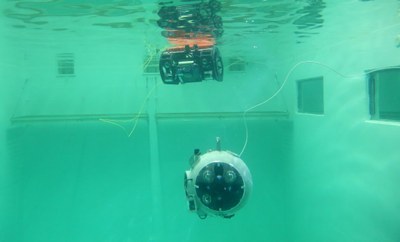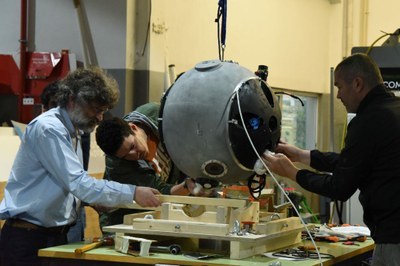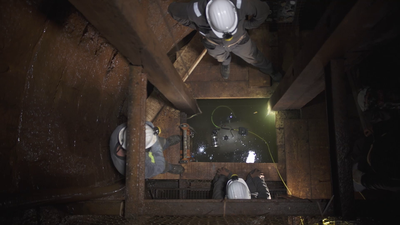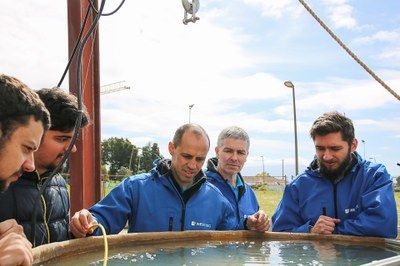INESC TEC successfully tests robot to explore flooded mines
It was at the beginning of April that the robot, developed under the European project UNEXMIN, was successfully tested in the former Urgeiriça uranium mine (Nelas, Viseu). The project, which was funded by the European Union’s Horizon 2020 programme and which developed an autonomous robotic platform for researching and mapping flooded underground mines, brought together twelve organisations from seven different countries.
aBOUT UNEXMIN
UNEXMIN includes the development of three robots for 3D mapping and for gathering geological data that cannot be obtained otherwise without incurring major costs or other associated risks, such as human risks in case divers are used for research or collection of data in mines. In Portugal, INESC TEC and the Empresa de Desenvolvimento Mineiro (EDM) are the partners of this project.

“In Europe, there are around 30 000 closed mines, many of which still have important mining resources that can be exploited. Many of these mines are now flooded, thus making their exploration and assessment a difficult process. At the moment, there is a lack of data and information on their current state due to the high monetary costs and danger that are associated to the current methods. For this reason, the solutions that we're developing under UNEXMIN can make the difference”, explains Alfredo Martins, researcher from INESC TEC’s Centre for Robotics and Autonomous Systems (CRAS).
The UNEXMIN technology represents a new era in the support of the mining exploration: robots that can autonomously operate in these environments – the UX-1 robots are the first ones of this type. At the moment, the UNEXMIN platform has two robots and a third one is on the way.

The tests
The first prototype and the technology itself were already tested in June 2018 in the mines of Kaatiala, Finland, and in September 2018 in Idrija, Slovenia, with good results: the robot was operational and the flooded mines were mapped.
The third test took place at the beginning of April in the former Urgeiriça mine. The robots were tested in groundwater of the former Urgeiriça uranium mine. The tests were successful and, for that reason, it was possible to research, collect images and to create maps of galleries and flooded tunnels, specially focusing on the autonomy and mapping, thus proving the functioning of the robotic platform in a mine with different features from the others.

The role of INESC TEC
Besides the project and the global architecture of the system and of the robot, INESC TEC is also responsible for the navigation, perception and mapping software. The vast experience of INESC TEC's team in the development of underwater robots and autonomous systems also allowed its selection as the partner responsible for the task of global integration of the robots.
Besides this, INESC TEC developed an innovative underwater mapping sensor based on structured light that, when integrated in the UNEXMIN robots, allows mapping with millimetre precision in situations in which the water visibility allows it.
The future
The development of the UNEXMIN platform will enable many scenarios to be opened for the exploration of minerals essential for the development of several industries. The UNEXMIN platform can contribute decisively to the assessment of the reopening of mines, which used to be closed due to the high costs of the exploration compared to the amount of the existing minerals.
The technology that is currently available can also allow to make an initial low-cost and low-risk assessment of the viability of these mines, to collect data about their status and to map artefacts with historical interest that might have remained abandoned.
With UNEXMIN, the strategic opportunity of reopening flooded mines in Europe is created. Most of these mines still have a considerable percentage of essential mineral raw materials that can be exploited, favouring the Portuguese and European economy.
The UNEXMIN project will end in October of 2019. A spin-off for the service provision in flooded mines that uses the robots developed under this project was already created.

Besides INESC TEC and EDM in Portugal, the UNEXMIN project, which was coordinated by the University of Miskolc (Hungary), also had the following partners: Geological Survey of Slovenia of Slovenia, Tampere University (Finland), Universidad Politécnica de Madrid (Spain), La Palma Research Centre (Spain) Resources Computing International (the United Kingdom), Ecton Mine Educational Trust (the United Kingdom), European Federation of Geologists (France), Geo-Montan (Hungary) and Idrija Mercury Heritage Management Centre (Slovenia).
The INESC TEC's researchers that participated in the UNEXMIN project are: Alfredo Martins, José Miguel Almeida, Eduardo Silva, Carlos Almeida, Ricardo Pereira, Eduardo Soares, Denys Sytnyk, Bruno Matias, Tiago Pereira, António Ferreira and Diana Viegas.
The researchers mentioned in this news piece are associated with INESC TEC and P.Porto-ISEP.


